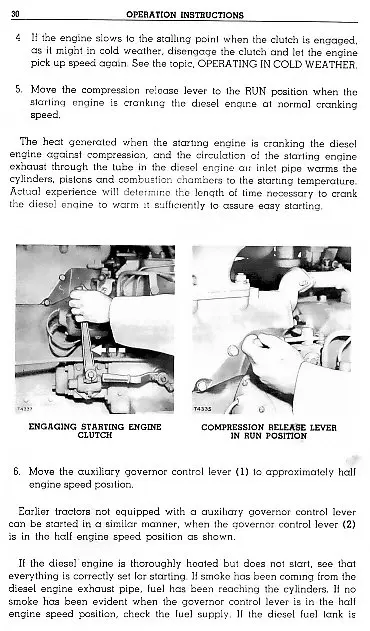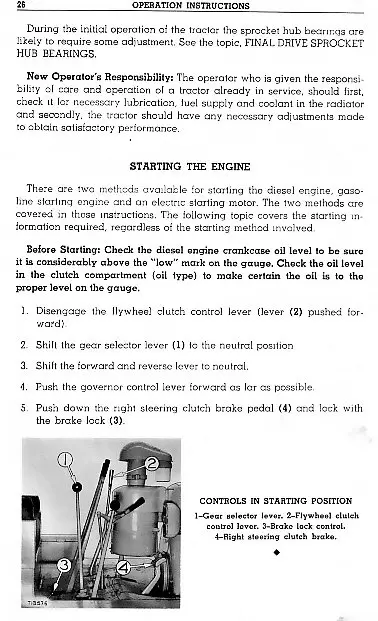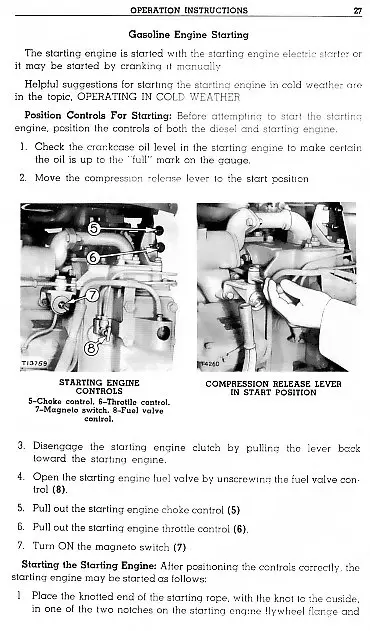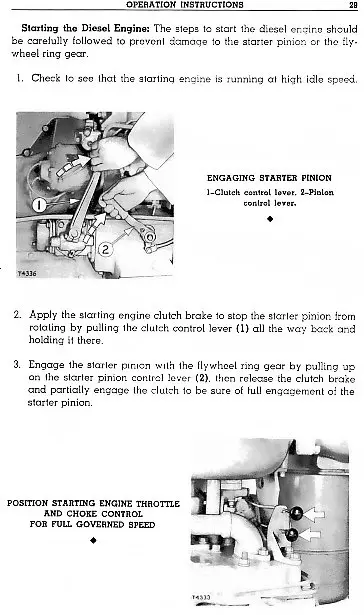First and very important, prestart checks.....
-Oil in main engine (will check as too full on the stick since it is marked for engine idling conditions)
-Coolant in main (if it's low, fill it and then bleed air from small line between pony motor and main engine head which is under the hood near decompression lever above pony switch and starter button)
-Oil in injection pump housing (check/fill plug on side with a slot in a hex shaped plug) full of motor oil until it runs out
-Oil in pony pinion clutch. (check with plug on side of housing near where the lever attaches and if necessary , you can take top plug or cover off to fill........some have only a pipe plug there, most have a flat cover held on by a couple bolts)
-Oil in pony motor. Check if it's diluted with gasoline or over full. If it is, drain it and refill. Takes only a quart and a half I think on that pony
-Fuel in diesel tank and gasoline in pony tank. Pony tank will have some gas visible in the bottom even when it is out.
-Diesel engine throttle closed (push hard forward on lever near air filter)
-Transmission shifter in neutral and clutch lever can be either pulled back to engage it or pushed forward to disengage it. Best to have it disengaged for starting, but don't only disengage the clutch because climbing in the seat etc, it would be easy to hit the clutch and make the machine take off if it's not in neutral. Also an oil clutch machine with the clutch disengaged, but the transmission in gear will sometimes move a little when it first starts because of drag from the oil between the disks in the clutch. That is not a good thing, really gets a good "pucker" response when you're sitting on the track and it starts moving!
-Set the brake (right one only, small latch near base of seat in floor of tractor, press the pedal and flip the latch down to hold it) Set it tight so you don't drive off with it on, you want it to be obvious there's something wrong if you forget to release it!
Drain pony cylinders with petcocks to remove any accumulated liquids. Turn pony over a few times with them open to clear them most effectively and then close them.
Turn on gas to pony carburetor, put on ear muffs😆 and start it. If it will idle, let it warm up idling slow and engage the pinion before speeding it up.
Engage pinion (the rearmost lever near the clutch housing) by first braking the pinion by pushing the pinion clutch lever hard toward the back of the tractor and then pulling up/back on the pinion shift lever until it snaps the pinion latch mechanism in and the lever flops back down under no pressure.
Decompress the main engine by pulling the short lever near the pony switch and start button straight out.
Speed up the pony motor by pushing in on the throttle knob. Pony is governed and pulling the throttle knob out limits the throttle travel to slow the pony down. Pushing it in releases the throttle and lets it respond to the load as required.
Engage the pinion clutch by pushing the clutch lever forward. It should snap over center quite easily and begin to turn the main engine. You should not have to hold the clutch lever forward or the pinion shift lever back to turn the engine. Holding the pinion shift lever up to keep the pinion engaged will sooner or later result in damage to the shift mechanism and require removing the clutch or pulling the engine to repair depending on the age of the tractor.
Check for fuel pressure on gauge near fan on left side and oil pressure on gauge near air filter. Fuel pressure is frequently not out of the red until the main engine starts, but any movement off the peg usually means the main engine should get enough fuel to start.
Release the decompression lever and let the main engine warm up from the heat of compression. Keep the throttle closed (in the seat, push it forward hard to put it over the detent into the fuel off position) until the main engine is warmed sufficiently to start cleanly. This will depend on the air and engine temperatures, but usually in summer, a couple minutes is plenty, in winter maybe 5 to 10 will get most of them ready.
Open throttle to about half way, pull on it hard, sometimes the linkage binds and it can take quite a tug to get the governor over it's shut-off detent. If main engine doesn't start within a few seconds or at least start blowing black smoke puffs, close it again. As soon as the throttle is opened, you should see lots of white smoke (diesel) from the exhaust even if the main engine isn't hot enough to start. If it's puffing black, it's almost there, try changing the throttle setting and even disengage the pinion clutch if it has unloaded the pony motor, but won't quite take off on it's own. Had one that had to have the clutch released before it would go off on its own, but usually the main will speed right up once it fires.
If the main engine stops turning instead of starting, usually the pinion kicks out when a cylinder or two fires and the main engine stops. Close the diesel throttle again, decompress it, brake the pinion (slow the pony down if necessary to keep from grinding the pinion gear into the flywheel), engage the pinion clutch, speed up the pony and engage the pinion clutch. Apply compression and let it warm up some more before opening the throttle again. If this is a chronic problem, the pinion engagement mechanism needs attention, perhaps adjusting the springs or replacement of worn parts.
When the main engine has started, it will kick the pony pinion out. In the unlikely event it doesn't and begins to overspeed the pony, disengage the pinion clutch and hope for the best on the pinion😆 Idle pony motor down, shut off gasoline valve and let it burn the carburetor dry. This avoids getting the oil sump full of gasoline when the pony carburetor float shakes as the tractor moves.
Release the brake! Drive tractor
D2-5J's, D6-9U's, D318 and D333 power units, 12E-99E grader, 922B & 944A wheel loaders, D330C generator set, DW20 water tanker and a bunch of Jersey cows to take care of in my spare time😄





